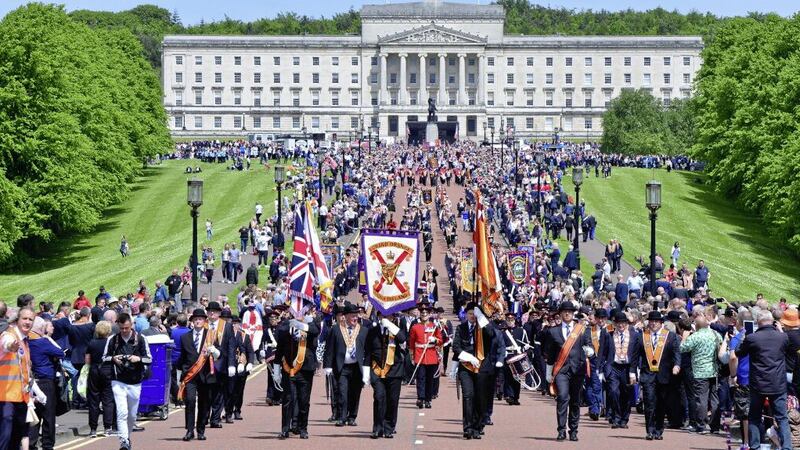It was disappointing to see Patricia Mac Bride promote misleading views on Bloody Sunday in her column (February 3).
As Lord Saville established, the narrative referred to in Mac Bride’s column first emerged from the British state’s response to manage global reaction after events in Derry on January 30 1972.
Irish News columnist Patrick Murphy noted this British response necessitated the demonising of the Irish nation as terrorists (February 5). And to validate this demonisation, between 1972-1998, the British state demonstrated a ‘civil war’ taking place in Northern Ireland rather than a campaign for civil rights.
Now, post-Saville, this ‘counter-insurgency’ narrative, of a physical force Irish nationalist civil war, is sustained through opinions of the sort set out in Ms Mac Bride’s column.
However, there is more beyond these narratives: Drawing on its political, social, economic, intellectual and cultural capital, the Irish nation was non-violently steered through a series of historic events.
From the Sunningdale Agreement (1973) and Anglo-Irish Agreement (1985) to the Downing Street Declaration (1993) and the paramilitary ceasefires (1994), followed by the Belfast/Good Friday Agreement (1998), the disarmament of paramilitary groups (2005-2010) and the withdrawal of British troops to barracks (2007) - as well as a public apology from the British prime minister (2010) for the actions of the British state on January 30 1972- this process of non-violent British state transformation helped the Irish nation finally resolve the ‘war’ in Ireland.
When put this way, what the Irish nation achieved after Bloody Sunday, non-violently, appears astonishing.
However, to those promoting Britain’s counter-insurgency narratives, of a physical force Irish nationalist ‘civil war’, such achievements now appear to be considered somewhat, ‘meh’.
Instead, the old British state racist idea of the Irish nation as ‘terrorist’ is sustained, where – as GK Chesterton wrote - “all their wars are merry and all their songs are sad”. But just because such songs play well does not mean they represent how the Irish nation actually responded after Bloody Sunday.
As already shown, from Sunningdale in ’73 to Stormont in ’98, the Irish nation responded non-violently to secure peace and the demands of the marchers from January 30 1972.
DR SEÁN BRENNAN
Independent Peace Researcher, Belfast
Grammatical analysis
Breandán MacCollaim’s riposte to my strictures on fake Irish (January 31), I suspected that the “dearg le fearg” tendency would be ready with tooth and claw to defend government Irish.
I don’t know where to start, but to borrow a phrase from Catholic theology: the sinner cannot be condemned to hell if he is in a “state of invincible ignorance”.
For brevity I will deal only with a couple of points. First ‘gardaí amháin’ (one policemen): I was crossing the street in Dublin the other day when I saw a sign for ‘trams only’. It was translated as ‘ach amháin tramanna’. Mirabile dictú. They got it right. Explain that one Breandán.
Breandán suggests that I use imagination to interpret ‘gardaí amháin’. I prefer to use rigorous grammatical analysis. His own gift of imagination extends to his homemade grammar, where nouns can become adjectives in the names of government departments. Does this include ‘An Roinn Gaeltachta’?
The definition of an impersonal verb form is that it stands in a vacuum, cannot have a subject or object or be used otherwise than free-standing. It certainly cannot be an imperative. The idea of a negative impersonal would require imagining a fourth or fifth dimension of consciousness. But imagination is invincible for its adherents.
Imperatives exist only for the second persons singular and plural. To express an injunction without a subject, or in the first or third person requires the subjunctive as in ‘go rabh maith agat’, or ‘nár ligidh Dia é’ (God forbid), or ‘ná caithtear tobac’ in the passive, (which can have subjects and negatives). English uses ‘let’s’, ‘let it’ etc.
The Dublin government at least got the name of the PM’s department right – ‘Roinn an Taoisigh’ as the taoiseach is specific. But wait! We have two rotating gyrating taoisigh, where one steps out and the other steps in again á la Lannigan’s Ball. So maybe it should be ‘Roinn na dTaoiseach’ modelled on ‘Bord na gCon’, in case Mary Lou gate-crashes the dance.
BRIAN MacLOCHLAINN
Glenarm, Co Antrim
Poots is a product of ‘Orange age’
THE Irish News (January 31) quotes Brian Feeney as follows: “(Edwin) Poots is a dinosaur... the people he appointed is a clear indicator of the Mesolithic era he lives in”.
For a historian, Mr Feeney is a bit muddled in his dates. Archeologists tell us that the dinosaur became extinct about 65 million years ago, and that the mesolithic (middle stone) age lies somewhere between the years 10,000 BCE and 8,000 BCE. The mystery deepens further when we remember that Mr Poots himself believes our world came into existence in the year 4,000 BCE. It would be more accurate, and fairer to Mr Poots, to call him a product of the Orange Age, which began in or around the year 1690 CE, and is currently coming to a close. Future historians, when they look back to this age, and move on from terminology such as ‘dinosaur’ and ‘mesolithic’, and wish to describe people who live in a time warp, will have a ready-made term at their disposal – ‘Orangemen’.
MALACHY O HIGGINS
Portaferry, Co Down
Low-cost defence measures
Patrick Murphy’s Saturday column (February 5) suggests that Simon Coveney TD should invest in a large white flag, instead of purchasing additional military hardware.
Additional savings could be made by scrapping the Department of Defence entirely and using the airwaves to broadcast a “We Surrender” message in Russian, Chinese, English, Gaeilge, etc.
FRANK PATTERSON
Wezembeeck-Oppem, Belgium







